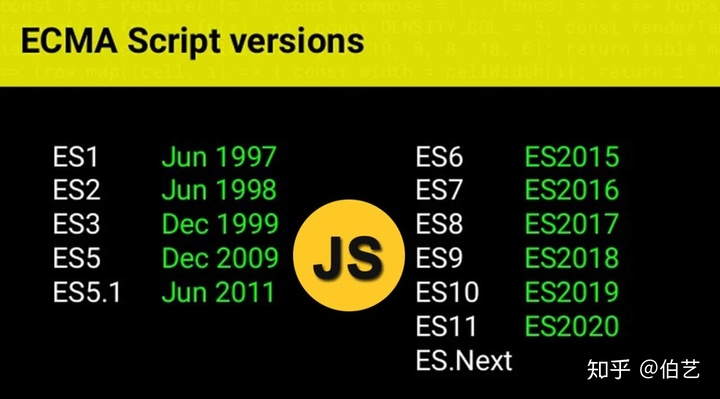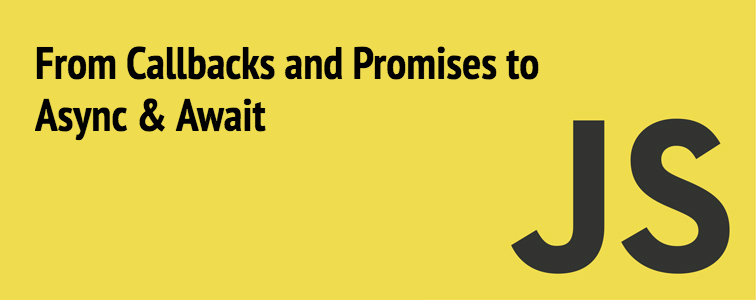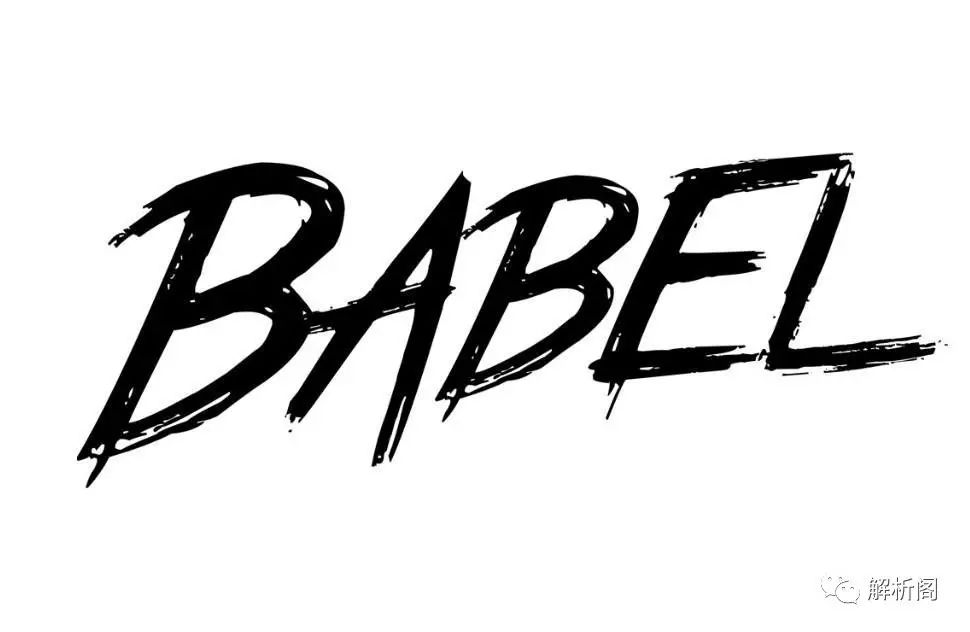
对于 ES6 + 新特性 ,是面试中常问的基础问题,例如:箭头函数、对象、异步、模块、类等特性。所以需要非常熟悉。
在review代码的过程中,我们发现比较多的 “混合” 写法导致代码可读性以及可维护性变差,代码混乱。特别是多人协作的中大型项目,代码一致性尤为重要。
对象合并Case:
// es5 写法
// 此处有更正
// API:Object.assign(target, ...sources)
// var obj3 = Object.assign(obj1, obj2)
// 更严谨的写法,感谢指正
var obj3 = Object.assign({}, obj1, obj2)
// es6 写法
const obj3 = {...obj1, ...obj2}
我们需要为团队制定代码规范,保证代码风格的一致性,同时要用工具去自动检测和自动修复,这些都是工程化中必不可少的,但更为重要的是充分 ECMAScript 的特性。
本文是对最常见特性的总结
ES1/ES2/ES3/ES5/ES6/ES7/ES8...& ES2015 / ES2016 / ES2017 / ES2018... 对于初学者来说比较容易搞懵,以下是一张 ECMAScript 发展史图:

参考:https://morioh.com/p/7558b17326cb
特性
- 箭头函数(arrow function)
- 对象(object)
- 异步(async / await)
- 模块(module)
- 类(class)
一、箭头函数 (=>)
ES5
function greetings (name) {
return 'hello ' + name
}
ES6
// 该例子同时包含了:模版字符串的用法
// 模板字符串(template string)是增强版的字符串,用反引号(`)标识。
// 它可以当作普通字符串使用,也可以用来定义多行字符串,或者在字符串中嵌入变量。
const greetings = (name) => {
return `hello ${name}`;
}
如果只有一个参数可以省略掉括号
const greetings = name => `hello ${name}`;
二、操作对象(objects)
2.1 对象合并
ES5
var obj1 = { a: 1, b: 2 }
var obj2 = { a: 2, c: 3, d: 4}
var obj3 = Object.assign({}, obj1, obj2)
ES6
const obj1 = { a: 1, b: 2 }
const obj2 = { a: 2, c: 3, d: 4 }
const obj3 = { ...obj1, ...obj2 }
2.2 对象解构
ES5
var obj1 = { a: 1, b: 2, c: 3, d: 4 }
var a = obj1.a
var b = obj1.b
var c = obj1.c
var d = obj1.d
ES6
const obj1 = { a: 1, b: 2, c: 3, d: 4 }
const {
a,
b,
c,
d
} = obj1
2.3 对象定义
ES5
var a = 1
var b = 2
var c = 3
var d = 4
var obj = { a: a, b: b, c: c, d: d }
ES6
// 前提是:属性名 与 变量名 一致
const a = 1
const b = 2
const c = 3
const d = 4
const obj = { a, b, c, d }
三、异步(promise / callback)
伯艺:使用Javascript如何优雅的编写异步代码zhuanlan.zhihu.com
ES5
function isGreater (a, b, cb) {
var greater = false
if(a > b) {
greater = true
}
cb(greater)
}
isGreater(1, 2, function (result) {
if(result) {
console.log('greater');
} else {
console.log('smaller')
}
})
ES6
- 代码结构变得更清晰,易读性更好。
- 异常处理方式更合理。
const isGreater = (a, b) => {
return new Promise ((resolve, reject) => {
if(a > b) {
resolve(true)
} else {
reject(false)
}
})
}
isGreater(1, 2)
.then(result => {
console.log('greater')
})
.catch(result => {
console.log('smaller')
})
ES8
ES6 的 Promise 使得 异步编程变得可读、可控。但必须使用链式方式写代码。ES8 引入了 async / await 关键字,使得可以像写同步代码一样编写异步代码:
const isGreater = (a, b) => {
return new Promise ((resolve, reject) => {
if(a > b) {
resolve(true)
} else {
reject(false)
}
})
}
async function test() {
const result = await isGreater(1, 2)
console.log(result);
}
test()
// false
四、模块(Module)export / import
模块指的是一段可复用的代码块,在内部封装了实现细节,并对外提供一个公共API,以便其它代码可以更好的加载和使用它。
严格的来说在 ES6 / ECMAScript2016 出现之前,JavaScript 没有定义 模块的官方语法,然后社区开发者自行发明了一些定义模块的方式:
- Asynchronous Module Definition (AMD):异步加载,依赖前置。
require.js - Common Module Definition(CMD):异步加载,依赖就近。
sea.js - Universal Module Definition (UMD):类似于自执行函数。browser / Node.js 都可用
- CommonJS:一个文件一个模块,同步加载。browser / Node.js 都可用
由于Node.js 采用的是CommonJS 模块方式,也被借鉴到 浏览器端(browser)。我们通常说的 ES5 规范实际上指的就是 CommonJS 模块规范。
https://www.jvandemo.com/a-10-minute-primer-to-javascript-modules-module-formats-module-loaders-and-module-bundlers/#www.jvandemo.comES5
var MyComponent = { x: 1, y: function(){ console.log('This is ES5') }}
module.exports = MyComponent;
ES6
const MyComponent = { x: 1, y: () => { console.log('This is ES6') }}
export default myModule;
ES6 提供了两种导出模块的方式
- 命名导出(Named Export)
MyComponent.js
export const MyComponent1 = () => {
return 'MyComponent1';
}
export const MyComponent2 = () => {
return 'MyComponent2';
}
index.js
// 方式1
import { MyComponent1, MyComponent2 } from "./MyComponent"
// 方式2 重命名
import * as MainComponents from "./MyComponent";
// MainComponents.MyComponent1
// MainComponents.MyComponent2
//
- 默认导出(export default)
MyDefaultExport.js
// export
export default MyComponent = () => {
return 'MyComponent'
}
index.js
// import
import MyDefaultComponent from "./MyDefaultExport";
两种导出方式,根据实际情况选择,如果需要导出多个值就用命名导出,否则就用默认导出。
五、类 (class)
ES6 原生支持 class 以及 extends
class
// ===============================================
// 1. 通过 class 关键词 创建类
// ===============================================
class People {
constructor(name, age){
this.name = name;
this.age = age;
}
sayName(){
console.log(`hello ${this.name} !`);
}
}
let user1 = new People('name1', 21);
user1.sayName();
extends
// ===============================================
// 2. 通过 extends 实现继承
// ===============================================
class Student extends People{
constructor(name, age){
super(name); // 等同于 super.constructor(x)
this.age = age;
}
sayAge() {
console.log(`my name is ${this.name}, age is ${this.age}`);
}
}
let stu = new Student('name1', 100);
stu.sayAge();
stu.sayName();
ES5 只能通过对象模拟实现 class
class
可以通过,构造函数、工厂模式、字面量模式、原型模式、以及 组合模式实现class
// ===============================================
// 1. 构造函数模式 [不建议]
// ===============================================
function People(name, age){
this.name = name;
this.age = age;
this.toString = function(){
console.log(`my name is ${this.name},this year ${this.age}`);
}
}
var user = new People('will',21);
user.toString();
// ===============================================
// 2.工厂模式 [不建议]
// 该模式抽象了创建具体对象的过程
// 用函数来封装以特定接口创建对象的细节
// ===============================================
function People(name, age){
var obj = new Object();
obj.name = name;
obj.age = age;
obj.toString = function(){
console.log(`my name is ${this.name},this year ${this.age}`);
}
return obj;
}
var user = People('will', 21);
user.toString();
// ===============================================
// 3.字面量模式 [不建议]
// 字面量可以用来创建单个对象,但如果要创建多个对象,会产生大量的重复代码
// ===============================================
var People = {
name: 'will',
age : 21,
toString: function(){
console.log(`my name is ${this.name},this year ${this.age}`);
}
}
People.toString();
// ===============================================
// 4.原型模式 [不建议]
// 使用原型对象,可以让所有实例共享它的属性和方法
// ===============================================
function People(){
People.prototype.name = "will";
People.prototype.age = 21;
People.prototype.toString = function(){
console.log(`my name is ${this.name},this year ${this.age}`);
}
}
var user1 = new People();
user1.toString();
var user2 = new People();
user2.toString();
console.log(user1.toString == user2.toString); // true
// isPrototypeOf:检测,是否是该对象的实例对象
console.log(People.prototype.isPrototypeOf(user1)); // true
console.log(People.prototype.isPrototypeOf(user2)); // true
console.log(user1.__proto__ === People.prototype) // true
// hasOwnProperty: 检测 属性是否 存在实例中
console.log(user1.hasOwnProperty('name')); // false
// ===============================================
// 5.组合模式 [最佳实践]
// 最常见的方式
// 构造函数模式用于定义实例属性,而原型模式用于定义方法和共享的属性
// 这种组合模式还支持向构造函数传递参数。实例对象都有自己的一份实例属性的副本
// 同时又共享对方法的引用,最大限度地节省了内存。
// 该模式是目前使用最广泛、认同度最高的一种创建自定义对象的模式
// ===============================================
function People(name, age){
this.name = name;
this.age = age;
this.friends = ["a","b"];
}
People.prototype = {
toString : function(){
console.log(`my name is ${this.name},this year ${this.age}`);
}
}
var user1 = new People("name1", 10);
var user2 = new People("name2", 20);
console.log(user1.friends); // ["a", "b"]
user1.friends.push('c');
console.log(user1.friends); // ["a", "b", "c"]
console.log(user2.friends); // ["a", "b"]
user1.toString(); // my name is name1,this year 10
user2.toString(); // my name is name2,this year 20
console.log(user1.friends === user2.friends); // false
console.log(user1.toString === user2.toString); // true
extends
通过,原型链、借用构造函数、组合继承、原型式继承、寄生式继承、寄生组合式继实现 extends
// ===============================================
// 1. 原型链 [不建议]
// 问题1:对于包含引用类型值的原型属性,会被所有实列共享,所以我们更希望在构造函数中定义属性
// 问题2:在创建自类型实例时,不能给父类型传参
// ===============================================
function Super() {
this.super_age = 50
}
Super.prototype.getSuperAge = function() {
return this.super_age;
}
function Sub() {
this.sub_age = 20
}
Sub.prototype = new Super();
Sub.prototype.getSubAge = function() {
return this.sub_age;
}
var instance = new Sub();
console.log(instance.getSuperAge()); // 50
// instanceof:判断实例
// isPrototypeOf: 判断实例
console.log(instance instanceof Super) // true
console.log(instance instanceof Sub) // true
// ===============================================
// 2. 借用构造函数 [不建议]
// 通过调用 call() 和 apply(),实现在 Sub 实例环境下,调用 Super 构造函数,同时可以传递参数
// 存在问题:方法都在构造函数中定义,无法复用。
// ===============================================
function Super(name) {
this.name = name;
this.colors = ['red', 'blue'];
}
function Sub(name) {
Super.call(this, name);
this.age = 20;
}
var instance1 = new Sub('name1');
instance1.colors.push('yellow');
console.log(instance1.colors); // ['red', 'blue', 'yellow']
var instance2 = new Sub('name2');
console.log(instance2.colors); // ['red', 'blue']
// ===============================================
// 3. 组合继承 [伪经典继承] [常用]
// 原型(原型属性 + 方法 的继承) + 构造函数(实例属性的继承)
// 问题:调用两次 超类型构造函数(创建子类 + 子类构造函数内部)
// ===============================================
function Super(name) {
this.name = name;
this.colors = ['red', 'blue'];
}
Super.prototype.sayName = function() {
console.log(this.name);
}
function Sub(name, age) {
Super.call(this, name);
this.age = age;
}
Sub.prototype = new Super();
Sub.prototype.sayAge = function() {
console.log(this.age);
}
// ===============================================
// 3.原型式继承
// 问题:引用类型属性共享
// ===============================================
var person = {
name: 'p1',
friends: ['a', 'b', 'c']
}
var otherPerson1 = Object.create(person);
otherPerson1.name = 'p2';
otherPerson1.friends.push('d');
var otherPerson2 = Object.create(person);
otherPerson2.name = 'p3';
otherPerson2.friends.push('e');
console.log(otherPerson2.friends); // ['a', 'b', 'c', 'd']
// ===============================================
// 4.寄生式继承
// 创建一个仅用于封装继承过程的函数,该函数在内部以某种方式来增强对象,最后再返回该对象
// ===============================================
function createAnother(original) {
var clone = object(original); // 创建新对象
clone.sayHi = function() { // 增强这个对象
console.log('Hi');
}
return clone; // 返回 增强后的 对象
}
// ===============================================
// 5.寄生组合式继承
// 问题:引用类型属性共享
// ===============================================
function Super(name) {
this.name = name;
this.colors = ['red', 'blue'];
}
Super.prototype.sayName = function() {
console.log(this.name);
}
function Sub(name, age) {
Super.call(this, name);
this.age = age;
}
Sub.prototype = new Super();
// 借用构造函数:继承属性
// 原型链的混成形式:继承方法
// 基本思路:不必为了指定子类型的原型 而 调用父类型的构造函数。我们需要的是一个父类型原型的副本
// 本质:使用寄生式继承来继承超类型的原型,然后再将结果指定给子类型的原型。
function inheritPrototype(Super, Sub) {
var prototype = Object(Super.prototype); // 创建对象
prototype.constructor = Sub; // 增强对象
Sub.prototype = prototype; // 指定对象
}
inheritPrototype(Super, Sub);
Sub.prototype.sayAge = function() {
console.log(this.age);
}
参考:
https://medium.com/@etherealm/named-export-vs-default-export-in-es6-affb483a0910medium.com ES6 vs ES5 - Aaludra Technologiesaaludra.com






















 1万+
1万+

 被折叠的 条评论
为什么被折叠?
被折叠的 条评论
为什么被折叠?








